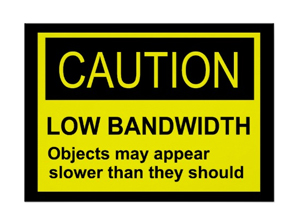By: John Shepler
The perfect network connection is invisible. Whether it uses copper wires, coaxial cable, fiber optics, or wireless technology, if it impacts your network traffic, it’s not truly transparent. The more noticeable these limitations become, the more they hinder productivity, demanding your attention.
Shared broadband services like Cable, DSL, 4G Cellular, or satellite internet, despite promising “best effort,” are inherently limited by technology and company policies. Each type has a maximum capacity, typically accessible round-the-clock, except for rare outages. However, users only get a fraction of this capacity.
Firstly, bandwidth is capped. You’re purchasing a maximum speed, not a guaranteed one. Providers control this with rate limits. Your line might support 1000 Mbps, but you’re restricted to 10, 30, or 100 Mbps, regardless of other users.
Secondly, usage limits are imposed, especially on wireless and satellite connections where bandwidth is costly. Limits like 5 or 10 GB per month severely restrict usage, and even 20 or 50 GB might be insufficient for regular business operations. Exceeding this limit can result in extra charges, disconnections, or slower speeds for the remainder of the billing cycle.
Actual Limitations
Private and dedicated internet connections usually avoid artificial limitations. These premium services ensure you’re the sole user, eliminating the need for usage policies.
However, technical limitations persist. Every technology has inherent constraints. “Unlimited” bandwidth is a myth, even on local networks. The goal is to have sufficient bandwidth to avoid reaching capacity.
T1 Line Saturation
T1 lines, offering dedicated connections between two points or to the internet, have been the business standard for decades. As the sole user, there are no usage restrictions, and the line constantly allows data transfer. You utilize and pay a fixed price for a portion or all available capacity.
T1 lines offer 1.5 Mbps bandwidth, more precisely 1.544 Mbps. However, 8 Kbps is reserved for line synchronization, leaving 1.536 Mbps for actual data – equivalent to 16.59 GB daily or nearly 500 GB monthly.
Line Saturation Problems
Your T1 line reveals its limitations when transferring large files quickly or accommodating multiple users simultaneously. With a maximum capacity of roughly 17 GB daily, transferring even 1 GB per hour becomes challenging.
Attempting to exceed this limit slows down everyone’s traffic significantly. This bottleneck hinders productivity, especially when access to information is crucial for continuing work.
The situation worsens with cloud-based phone systems (VoIP). Voice data gets stuck in the bottleneck alongside other data, causing call quality issues like garbled speech, delays, and even dropped calls.
Solutions
For occasional saturation, prioritizing traffic can be beneficial. Real-time services like calls and video conferences get top priority, followed by business applications, and finally, background tasks like backups.
Ultimately, upgrading to higher bandwidth becomes necessary. Fortunately, costs have decreased significantly. Doubling your bandwidth with a second T1 line is an option. These lines can be “bonded” to act as a single, faster connection.
Ethernet over Copper, using existing copper lines, offers speeds of 10 Mbps and beyond. For these speeds, Ethernet over Fiber becomes cost-effective, scaling from 10 to 100, 1000, and even 10,000 Mbps. These services allow you to start with a lower speed and pay less until full capacity is needed.
If your T1 lines or other connections are struggling, explore pricing and availability of higher bandwidth services for your business location.


